
Quercus coccinea, the scarlet oak, is a deciduous tree in the red oak section Lobatae of the genus Quercus, in the family Fagaceae. It can be mistaken for the pin oak, the black oak, or occasionally the red oak. On the scarlet oak the sinuses between lobes are "C"-shaped in comparison to pin oak, Quercus palustris, which has U-shaped sinuses and the acorns are half covered by a deep cap.

Cyclophora albipunctata, the birch mocha, is a moth of the family Geometridae. The species was first described by Johann Siegfried Hufnagel in 1767. It is found in the Palearctic. The southern boundary runs westward along the French Atlantic coast and to the British Isles and north of the Alps. In the east, the species ranges to the Pacific Ocean. South of the northern Alps line, it is found at some high elevation areas and mountains. In the Pyrenees, the Massif Central, the southern Alps, the northern Dinaric Alps, in the western and northern Carpathians, in northern Turkey and the Caucasus. In the north, the range extends up to the Arctic Circle. In the Far East the nominate subspecies is replaced by Cyclophora albipunctata griseolataStaudinger, 1897.

Cyclophora punctaria, the maiden's blush, is a moth of the family Geometridae. The species was first described by Carl Linnaeus in his 1758 10th edition of Systema Naturae. The species is mainly prevalent in Central and Eastern Europe. In the north, its distribution extends to southern Fennoscandia and the British Isles, in the west via France to parts of northern Spain, in the south via Italy, the Balkan Peninsula to Asia Minor. The eastern border of the distribution is roughly the Ural. In the Caucasus area, the nominate subspecies is replaced by the subspecies C. punctaria fritzae. The range of this subspecies extends as far as Iran.Cyclophora punctaria is found mainly in wooded areas with oak scrub and oak forests. In Central Europe it rises up to 700 metres in the hills, rarely up to 1,200 metres in the Alps, and regularly rises to 1,300 metres in southern Europe.

Cyclophora puppillaria, or Blair's mocha, is a moth of the family Geometridae. The species was first described by Jacob Hübner in 1799. It can be found in Europe and from North Africa up to the Caucasus area.
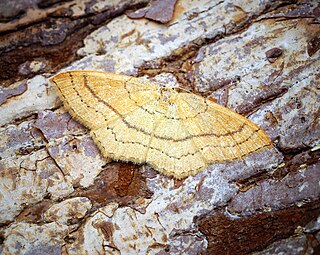
Cyclophora linearia, the clay triple-lines, is a moth of the family Geometridae. The species was first described by Jacob Hübner in 1799 and it can be found in Europe and Britain.

Cyclophora ruficiliaria, the Jersey mocha, is a moth of the family Geometridae. The species was first described by Gottlieb August Wilhelm Herrich-Schäffer in 1855. It can be found in Europe, in particular the Channel Islands as well as other parts of the mainland United Kingdom.

Cyclophora annularia, the mocha, is a moth of the family Geometridae. The species was first described by Johan Christian Fabricius in 1775 and it can be found in Europe.
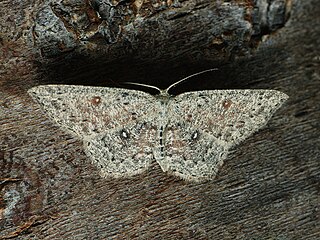
Cyclophora pendularia, the dingy mocha, is a moth of the family Geometridae. The species was first described by Carl Alexander Clerck in 1759 and it can be found in the Palearctic realm.

Cyclophora is a genus of moths in the family Geometridae. Many species are referred to as mochas in reference to their colouration, primarily in Europe.

Ditula angustiorana, the red-barred tortrix, is a moth of the family Tortricidae found in Africa, Asia, Europe and North Africa. Other common names are the fruit-tree tortrix and the vine tortrix. The moth was first described by Adrian Hardy Haworth in 1811.
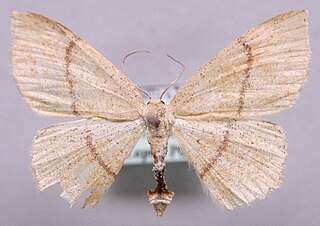
Cyclophora quercimontaria is a moth of the family Geometridae. It is found from southern Scandinavia to central and southern Europe and from western Russia to the Caucasus, northern Iran and the northern parts of Asia Minor.
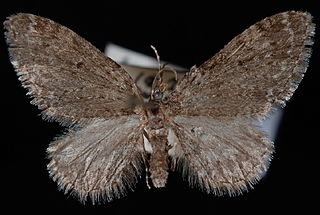
Eupithecia annulata, the larch pug moth, is a moth in the family Geometridae. The species was first described by George Duryea Hulst in 1896. It is found in North America from British Columbia north to the Yukon, east to Newfoundland and Labrador and south to California and Colorado.

Cyclophora lennigiaria is a moth in the family Geometridae. It is found in south-western Europe, north to southern France and western Germany, as well as in Morocco.
Cyclophora suppunctaria is a moth in the family Geometridae. It was described by Philipp Christoph Zeller in 1847. It is found in Spain, Andorra, France, Austria, Switzerland, Italy, Slovakia, Albania, Slovenia, Croatia, Bulgaria, Romania, Hungary, North Macedonia, Greece, on Sardinia, Corsica, Sicily and Crete, as well as in Tunisia, Turkey, Russia and Ukraine.

Cyclophora packardi, Packard's wave moth or Packard's wave, is a moth in the family Geometridae. It is found in North America, from Maine to Florida, west to Texas and north to Iowa and Ohio.
Cyclophora myrtaria, the waxmyrtle wave moth, is a moth in the family Geometridae. It is found in North America, where it is found along the Atlantic ocean plane.

Cyclophora pendulinaria, the sweetfern geometer moth or pearly-grey wave, is a moth in the family Geometridae. It is found in North America, where it is found from Newfoundland and Labrador west to the Yukon and coastal British Columbia, south to Georgia in the east. The habitat consists of moist or mesic forests.
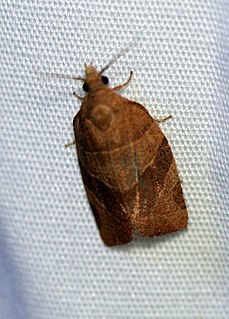
Pandemis limitata, the three-lined leafroller, is a species of moth of the family Tortricidae. It is found in North America, where it has been recorded from Nova Scotia to British Columbia and from the east coast west to the Rocky Mountains and Arizona. It has also been recorded from Durango in Mexico.

Pandemis lamprosana, the woodgrain leafroller moth, is a species of moth of the family Tortricidae. It is found in North America, where it has been recorded from the north-eastern United States, Quebec and Ontario.

Cleora sublunaria, the double-lined gray moth, is a species of moth of the family Geometridae. It is found in North America, where it has been recorded from south-eastern United States west to Texas.


















